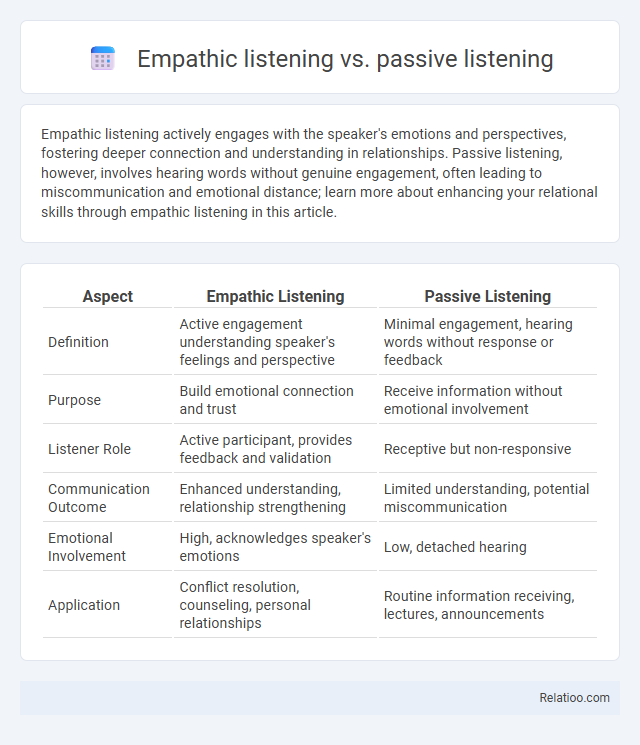Empathic listening actively engages with the speaker's emotions and perspectives, fostering deeper connection and understanding in relationships. Passive listening, however, involves hearing words without genuine engagement, often leading to miscommunication and emotional distance; learn more about enhancing your relational skills through empathic listening in this article.
Table of Comparison
| Aspect | Empathic Listening | Passive Listening |
|---|---|---|
| Definition | Active engagement understanding speaker's feelings and perspective | Minimal engagement, hearing words without response or feedback |
| Purpose | Build emotional connection and trust | Receive information without emotional involvement |
| Listener Role | Active participant, provides feedback and validation | Receptive but non-responsive |
| Communication Outcome | Enhanced understanding, relationship strengthening | Limited understanding, potential miscommunication |
| Emotional Involvement | High, acknowledges speaker's emotions | Low, detached hearing |
| Application | Conflict resolution, counseling, personal relationships | Routine information receiving, lectures, announcements |
Understanding Empathic Listening
Empathic listening involves fully engaging with the speaker's emotions and perspectives, enabling deeper understanding and connection beyond the words spoken. Unlike passive listening, where one merely hears without active engagement, empathic listening requires attentiveness, reflection, and emotional resonance to accurately interpret the speaker's underlying feelings and intentions. Mastering empathic listening enhances communication effectiveness by fostering trust, reducing misunderstandings, and promoting emotional support in interpersonal interactions.
Defining Passive Listening
Passive listening involves hearing words without actively engaging or providing feedback, often leading to misunderstandings and reduced communication effectiveness. Empathic listening requires fully concentrating, understanding, and responding to the speaker's emotions and messages, fostering deeper connections and trust. Unlike passive listening, empathic listening promotes active involvement and emotional validation, enhancing interpersonal relationships.
Key Differences Between Empathic and Passive Listening
Empathic listening involves actively understanding and validating the speaker's emotions and perspectives, fostering deeper connection and trust. Passive listening, by contrast, is characterized by hearing words without engaging or responding meaningfully, often leading to misunderstandings or a lack of emotional support. Your communication improves significantly when you practice empathic listening, as it prioritizes emotional insight over mere auditory reception, unlike passive listening which lacks this depth.
Importance of Empathic Listening in Communication
Empathic listening enables deeper understanding and fosters trust by actively engaging with the speaker's emotions and perspectives, unlike passive listening, which involves minimal interaction and often leads to miscommunication. Empathic listening enhances emotional intelligence and strengthens relationships by validating feelings and demonstrating genuine concern. Prioritizing empathic listening in communication improves conflict resolution and promotes collaborative problem-solving in both personal and professional contexts.
Consequences of Passive Listening
Passive listening often leads to misunderstandings and decreased trust in communication, as listeners may miss critical emotional cues and nuanced information. Unlike empathic listening, which fosters deeper connection and emotional validation, passive listening can result in feelings of neglect and frustration for the speaker. Over time, this can damage relationships and hinder effective collaboration in both personal and professional settings.
Techniques to Develop Empathic Listening Skills
Empathic listening requires active engagement techniques such as maintaining eye contact, providing verbal affirmations, and reflecting feelings to understand the speaker's emotions deeply, unlike passive listening which involves minimal response and no feedback. Developing empathic listening skills involves practicing mindfulness to stay present, asking open-ended questions to encourage elaboration, and summarizing content to confirm comprehension. Consistent use of these techniques enhances emotional connection, improves communication accuracy, and fosters trust in interpersonal relationships.
Signs You Are Practicing Passive Listening
Signs you are practicing passive listening include minimal eye contact, frequent distractions, and lack of verbal or nonverbal feedback, which indicate your mind may not fully engage with the speaker's message. Unlike empathic listening that involves understanding and emotionally connecting with the speaker, passive listening often results in missed nuances and important details. Your ability to build trust and deeper relationships diminishes when you consistently rely on passive listening instead of actively showing empathy and comprehension.
Real-Life Examples: Empathic vs Passive Listening
Empathic listening involves actively engaging with the speaker's emotions and perspectives, as seen when a counselor deeply understands a client's feelings during therapy sessions. Passive listening merely hears words without emotional involvement, like a student nodding without processing the lecture content. Real-life scenarios highlight empathic listening's impact in building trust and rapport, while passive listening often leads to miscommunication and disconnect in relationships.
Benefits of Adopting Empathic Listening
Empathic listening fosters deeper emotional connections by actively understanding and validating the speaker's feelings, improving trust and communication effectiveness. Unlike passive listening, which simply hears words without engagement, empathic listening enhances conflict resolution and collaboration by promoting genuine empathy. This approach supports stronger relationships and psychological safety, which are essential for personal and professional growth.
Transforming Passive Listening Into Empathic Engagement
Passive listening involves merely hearing words without processing emotions or intent, leading to disengagement and misunderstandings. In contrast, empathic listening requires active attention, recognizing and validating the speaker's feelings to foster genuine connection and trust. Transforming passive listening into empathic engagement demands deliberate focus on nonverbal cues, reflective responses, and an open, nonjudgmental mindset that prioritizes understanding over responding.

Infographic: Empathic listening vs Passive listening
 relatioo.com
relatioo.com